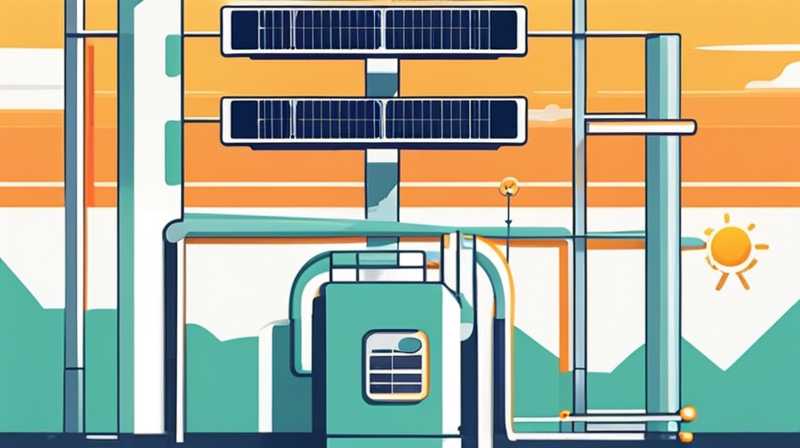
Cooling a solar power plant is essential for maintaining optimal efficiency and performance, particularly in high-temperature conditions. 1. Utilize innovative cooling technology, 2. Implement effective design strategies, 3. Consider water management systems, 4. Emphasize maintenance and operation practices are crucial for enhancing efficiency levels across solar installations. Among these, the use of innovative cooling technology, such as advanced heat transfer fluids or passive cooling methods, has garnered increasing attention for its potential to reduce temperature impacts effectively.
1. UNDERSTANDING THE IMPORTANCE OF COOLING IN SOLAR POWER PLANTS
The efficient operation of solar power plants is critically dependent on temperature control mechanisms. Increased thermal exposure can lead to a significant drop in performance, emphasizing the need for robust cooling strategies. When solar panels overheat, their ability to convert sunlight into electricity diminishes, which directly affects energy output and overall efficiency.
In the realm of renewable energy, solar power is often seen as a promising solution to the global energy crisis; however, the factor of heat management is frequently underestimated. Higher temperatures negatively impact the photovoltaic cells, often resulting in reduced voltage and, subsequently, lower output. Thorough understanding and management of cooling technologies in solar power plants can mitigate these issues and maintain sustainable energy production.
2. INNOVATIVE COOLING TECHNOLOGIES FOR SOLAR FACILITIES
Exploration of advanced cooling technologies can lead to enhanced productivity in solar plants. One notable example is the introduction of phase change materials (PCMs), which store and release thermal energy as they transition between different phases. By utilizing PCMs, operators can regulate temperatures more effectively, minimizing thermal stress during peak sunlight conditions.
In addition to PCMs, emerging heat transfer fluids used in concentrated solar power (CSP) systems are showing promising results. These fluids can absorb and transport heat more effectively than conventional options, facilitating efficient energy conversion even at elevated temperatures. Research into nanofluids—liquids mixed with nanoparticles—suggests improved thermal properties such as enhanced conductivity, making them an exciting area of development.
3. ADVANCED DESIGN STRATEGIES FOR OPTIMAL COOLING
Designing solar power plants with cooling in mind is foundational for long-term efficiency. Proper siting and orientation of solar panels can create passive cooling strategies. For instance, maximizing airflow through optimal arrangement can help dissipate heat naturally. Vertical installations, where panels stand upright rather than flat, have been observed to promote better airflow and reduce surface temperatures.
Furthermore, incorporating reflective materials or coatings on the surface of solar panels can help mitigate heat absorption. These coatings can minimize thermal radiation effects and improve moderation of panel temperatures. Creative design approaches not only improve energy yield but also extend the lifespan of solar installations.
4. EFFECTIVE WATER MANAGEMENT SYSTEMS
Water serves as a pivotal medium in cooling strategies for solar power plants, particularly in thermodynamic systems. Evaporative cooling systems utilize water to reduce temperature through the process of evaporation. This technology can significantly enhance the heat dissipation capability; however, it raises questions regarding water use and sustainability.
To address water scarcity concerns, innovations in water recycling and filtration systems can contribute towards improved plant efficiency. Techniques that capture and reuse water from cooling processes minimize the demand on local water sources, aligning energy production with ecosystem sustainability principles. A balanced approach toward water management is fundamental in ensuring that solar power remains an environmentally friendly energy option.
5. OPTIMIZING MAINTENANCE AND OPERATION PRACTICES
Routine maintenance and operational practices are vital for ensuring that cooling mechanisms function effectively. Scheduled checks of cooling systems—such as cleaning and maintaining PCM or evaporative cooling systems—should be prioritized. Regular inspection and servicing help preemptively address issues that could lead to increased operational temperatures.
Training personnel in effective cooling practices not only fosters a culture of maintenance but also equips teams to adopt best practices in real-time operations. Automated monitoring systems can further streamline this process by providing data-driven insights and alerting operators when temperature thresholds are approached, effectively preventing overheating scenarios.
FAQs
WHAT IS THE MAIN CHALLENGE IN COOLING SOLAR POWER PLANTS?
The primary challenge lies in managing excessive heat, which can significantly impair the efficiency and performance of photovoltaic cells. As temperatures rise, energy output diminishes, necessitating effective cooling mechanisms. Solutions may include innovative technologies like phase change materials or water management systems. Adopting comprehensive design strategies—focused on maximizing airflow and utilizing reflective materials—can also mitigate these challenges.
HOW CAN WATER USAGE BE SUSTAINABLE IN COOLING SYSTEMS?
Sustainable water management is achievable through innovative recycling practices. By capturing, filtering, and reusing water utilized in cooling mechanisms, solar power plants can significantly reduce their dependence on external water sources. Integrating efficient evaporative cooling systems, alongside state-of-the-art water filtration, ensures minimal environmental impact while maintaining operational efficiency.
WHAT IMPACT DOES OVERHEATING HAVE ON SOLAR EFFICIENCY?
Overheating in solar installations results in decreased voltage output and reduced overall energy conversion efficiency. Therefore, addressing high temperatures is paramount. Implementing passive and active cooling solutions—such as advanced heat transfer fluids and cooling designs—can counteract overheating effects, ultimately increasing energy production and prolonging the lifespan of solar technologies.
FINAL THOUGHTS ON OPTIMIZING COOLING STRATEGIES IN SOLAR POWER PLANTS
Efficient cooling mechanisms in solar power plants are not merely enhancements; they are essential components for the sustained success of solar energy systems. Without adequate cooling, energy production suffers, undermining the very purpose of solar photovoltaics as a sustainable energy solution. Emphasizing innovative technologies, creative design strategies, effective water management, and streamlined maintenance practices is vital for optimizing cooling systems and ensuring solar installations reach their full potential. Incorporating these facets allows operators to tackle the challenges posed by overheating while maximizing energy output. As technology advances and awareness of the importance of cooling grows, the solar energy industry stands poised for remarkable improvements in efficiency and sustainability. By investing in a multi-faceted approach to cooling, stakeholders can ensure that solar power remains a cornerstone of the renewable energy landscape, contributing positively to the global energy transition.
Original article by NenPower, If reposted, please credit the source: https://nenpower.com/blog/how-to-cool-a-solar-power-plant/


